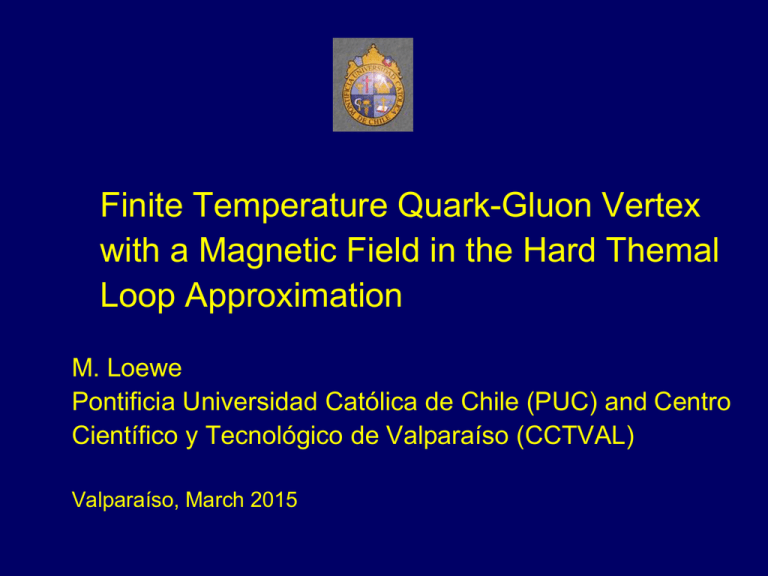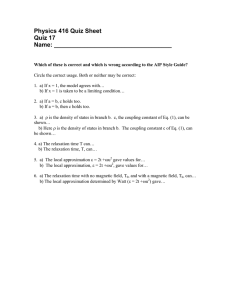Finite Temperature Quark-Gluon Vertex with a Magnetic Field in the
advertisement

Finite Temperature Quark-Gluon Vertex with a Magnetic Field in the Hard Themal Loop Approximation M. Loewe Pontificia Universidad Católica de Chile (PUC) and Centro Científico y Tecnológico de Valparaíso (CCTVAL) Valparaíso, March 2015 This talk is based on the following article: Finite temperature Quark-Gluon Vertex with a magnetic field in the hard thermal loop approximation. A. Ayala, J. J. Cobos-Martínez, M. Loewe, M. Elena Tejeda-Yeomans, and R. Zamora Physical Review D 91, 016007 (2015) I acknowledge support form : FONDECYT 1130056 and 1120770 (CHILE) Phase Diagram: Which will be the influence of an external Magnetic Field B? Huge Magnetic fields are produced in perhipheral heavy-ion collisions The intensity of the magnetic field decreases very rapidly as function of time • By the time the quarks and gluon thermalize the temperature becomes the largest of the energy scales. This means that the weak magnetic field approximation seems to be appropriate (eB <<T2). Recently, using the linear σ-model, we have shown the occurence of magnetic anti-catalysis (in agreement with results from the lattice). Tc (for chiral restoration) diminishes as function of B. • The idea is to consider the behavior of the QCD coupling constant (not an effective model) as function of the external B field as well as on temperature. E. Ferrer, V.de la Incera and X. J. Wen (arXiiv: 1407.3503) have considered this problem for the the strong magnetic field scenario (no temperature), finding an anisotropic behavior where the coupling decreases with B . • We will use the Schwinger propagator, in the weak magnetic field approximation, for the (charged) quarks in the triangle diagrams • Some technical details: The fermion propagator in the presence of an external homogeneous magnetic field B is given by where is a phase. It can be shown that for one or two fermion propagators, stemming from a common vertex, this phase factor can be gauged away. So, we will not take it into account. S(k) is the famous propagator for a charged fermion (q is the absolute value of the charge (in units of e) in the presence of a constant magnetic field pointing in the z direction. (Schwinger, 1951) We use the notation The expansion of S(k) for small values of qB, up to the order O(qB), takes the form So, we have to insert this propagator in order to get the thermo-magnetic correction to the QCD coupling For the first diagram, (the QED-like vertex correction) we have Form the second diagram (the genuine non-abelian vertex co rrection) we have In both diagrams the following notation has been used • Where the Matsubara frequencies are given by We are in the Euclidean space According to the philosophy of the HTL approximation, we neglect the mass terms in the numerator. Remember that The wawy lines with a cross denote the insertion of the magnetic propagators • Further on, by introducing It can easily shown that In the spirit of the HTL approx., P1 and P2 are small and can be taken of the same order. Thus, to extract the leading temperature behavior, we may approximate • We can play the same game with the second diagram and we can combine both in a very compact expression where • I will not present here the techniques we employed for carrying on the sums over the Matsubara frequencies. Looking for the leading terms where • And where the function M2(T, m, qB) is given by It is important and interesting to notice that our vertex correction satisfies a QED-like Ward-identity. In fact Where Σ(p) corresponds to the self-energy correction to the quark propagator This remarkable result shows that even in the presence of a magnetic field, provided the temperature is the highest energy scale, the thermomagnetic correction to the vertex is gauge invariant. For computing the thermo-magnetic dependence of the Coupling we have to deal with For the sake of simplicity we choose the configuration where the momenta (vector components) make an angle θ12 = π. It turns out that only the 00 and 33 components (after returning To Minkowski) survive. These are the paralell components. • where and we have rearranged the γ matrices introducing the spin operator Σ3 It is natural to consider P0 = T and to take m as the thermal fermionic mass. • As it is well known, the purely thermal corrections to the quark-gluon vertex is given by (Le Bellac’s book) From this analysis we extracted the effective thermo-magnetic coupling (from the effective longitudinal vertex) Where we have used a spin proyection 1 for Σ3 and we calculated in the static limit. • In the next figure we show the behavior of geff(T,B) normalize with the thermal coupling Note that the effective thermo-magnetic coupling geff decreases as function of the magnetic field. The decrease becomes more relevant for higher values of αs. For the considered values it becomes 15%-25% smaller than the purely thermal correction for qB~T2~1. This decreasing behavior of the thermo-magnetic effective coupling was extremely important for getting magnetic anti-catalysis in effectives models CONCLUSIONS • We have computed the thermo-magnetic correction (TMC) to the quark-gluon vertex for weak magnetic field in the HTL approximation • This vertex satisfies a QED-like Ward identity with the quark self-energy. • The TMC is proportional to the spin componente in the direction of the magnetic field and affects only the longitudinal components. • The effective coupling decreases if the strength of the magnetic field increases.


